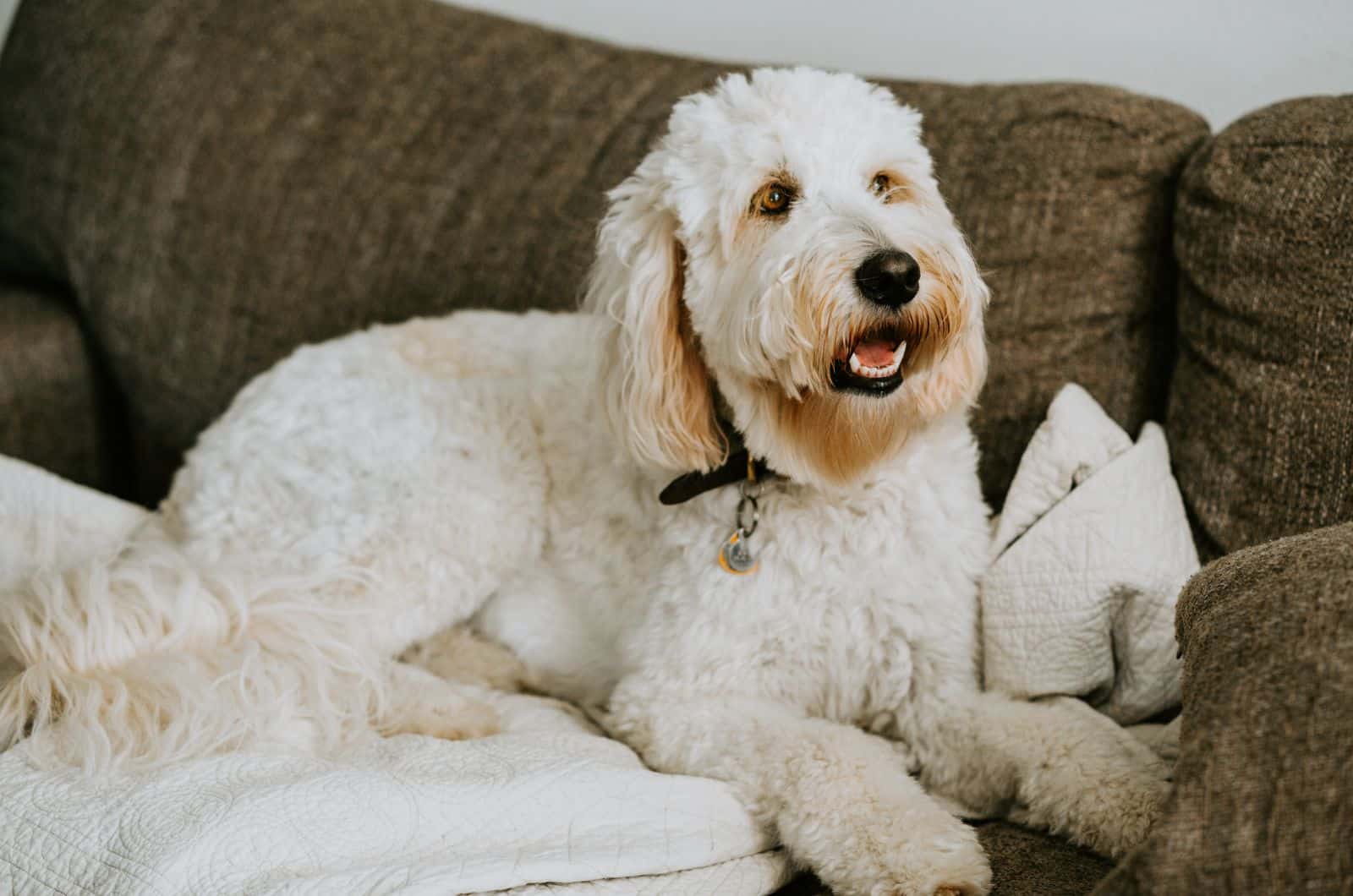A Flat coat Goldendoodle might not be as common as the one with wavy hair, but straight-haired pups do occasionally appear in litters of these mixed-breed canines.
That is why we decided to introduce you more closely to the straight-haired versions of Goldendoodles that are just as amazing as all other crossbreds.
If you want to learn more about this unusual type of Goldendoodle, keep on reading this article, which also contains useful tips for grooming flat-coat Doodles.
What is a Flat Coat Goldendoodle?
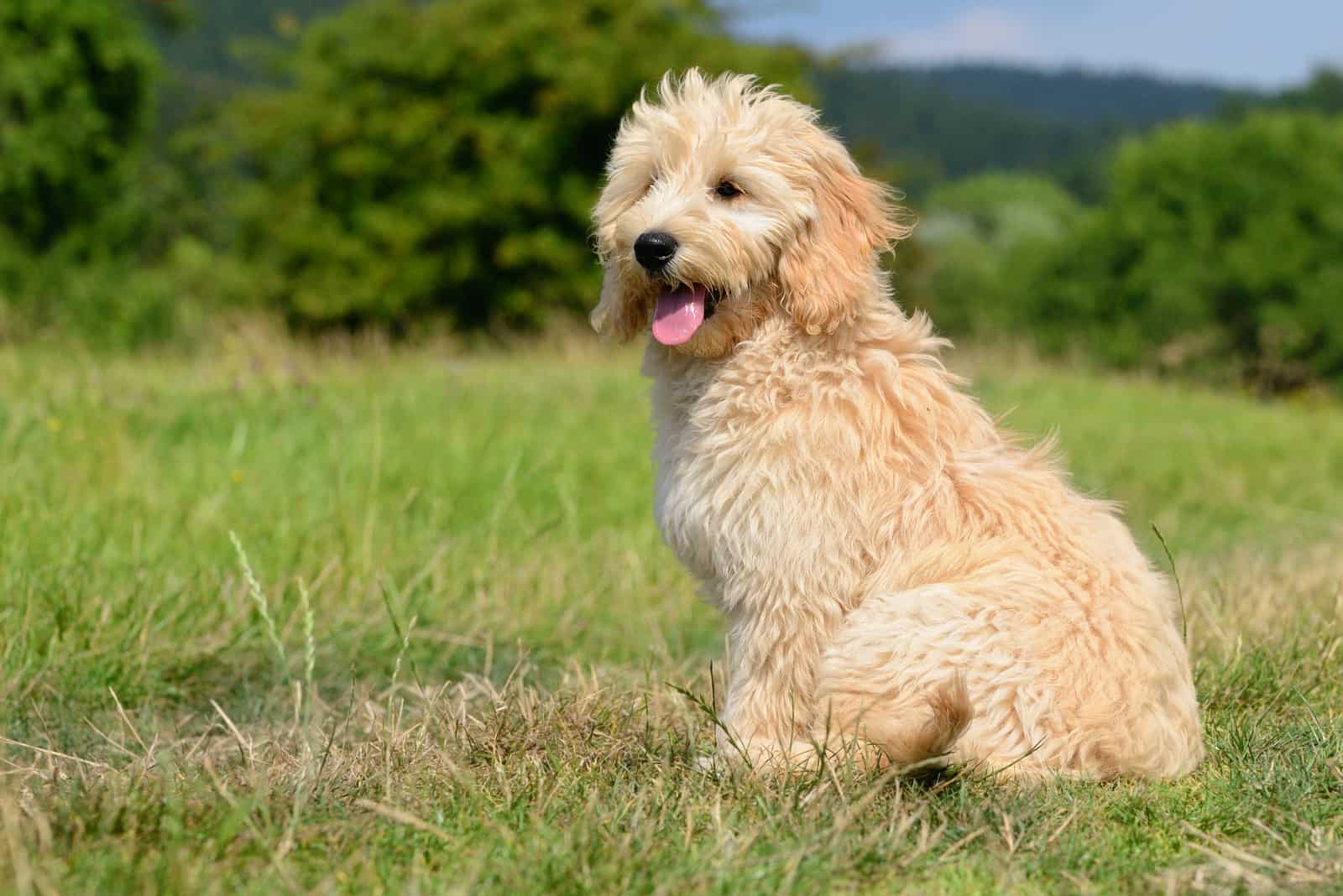
The simplest definition of a flat coat Goldendoodle would be that it is a type of Goldendoodle that doesn’t have any curl or waves, but completely straight hair instead.
The majority of Goldendoodle breeders strive to produce only puppies with the curly or wavy type of coat, which is why straight hair Goldendoodles are considered to have improper coats, although this is not necessarily true.
The presence or absence of furnishings in a Goldendoodle determines whether or not the breed has a flat coat.
The longer hair that forms furnishings is usually found on the Goldendoodle’s eyebrows, muzzle, and nose.
Not only are these hairs the most important factor in determining the type of coat, but they also play a role in determining whether the Goldendoodle will be hypoallergenic or not.
This is important information for people who have allergic reactions to dog hair, as many believe that all Goldendoodle puppies are allergy-friendly, although that might not be the case.
Why Does My Goldendoodle Have A Flat Coat?
Goldendoodle puppies generally inherit their physical appearance and personality traits from their parent breeds, just like children inherit characteristics from their parents.
The quality of the coat is just one of the many characteristics that Goldie puppies take from their parent breeds, Poodles and Golden Retrievers (if they’re F1 generation).
The texture of the hair can vary, not just from one litter of pups to the next, but also from one puppy to the next within the same litter.
A certain number of puppies from a Goldendoodle litter can have flat coats, while others might have more wavy or even curly hair.
This depends on several factors, which will be further explained in the next few paragraphs.
Common Reasons Why Some Goldendoodles Have Flat Coats
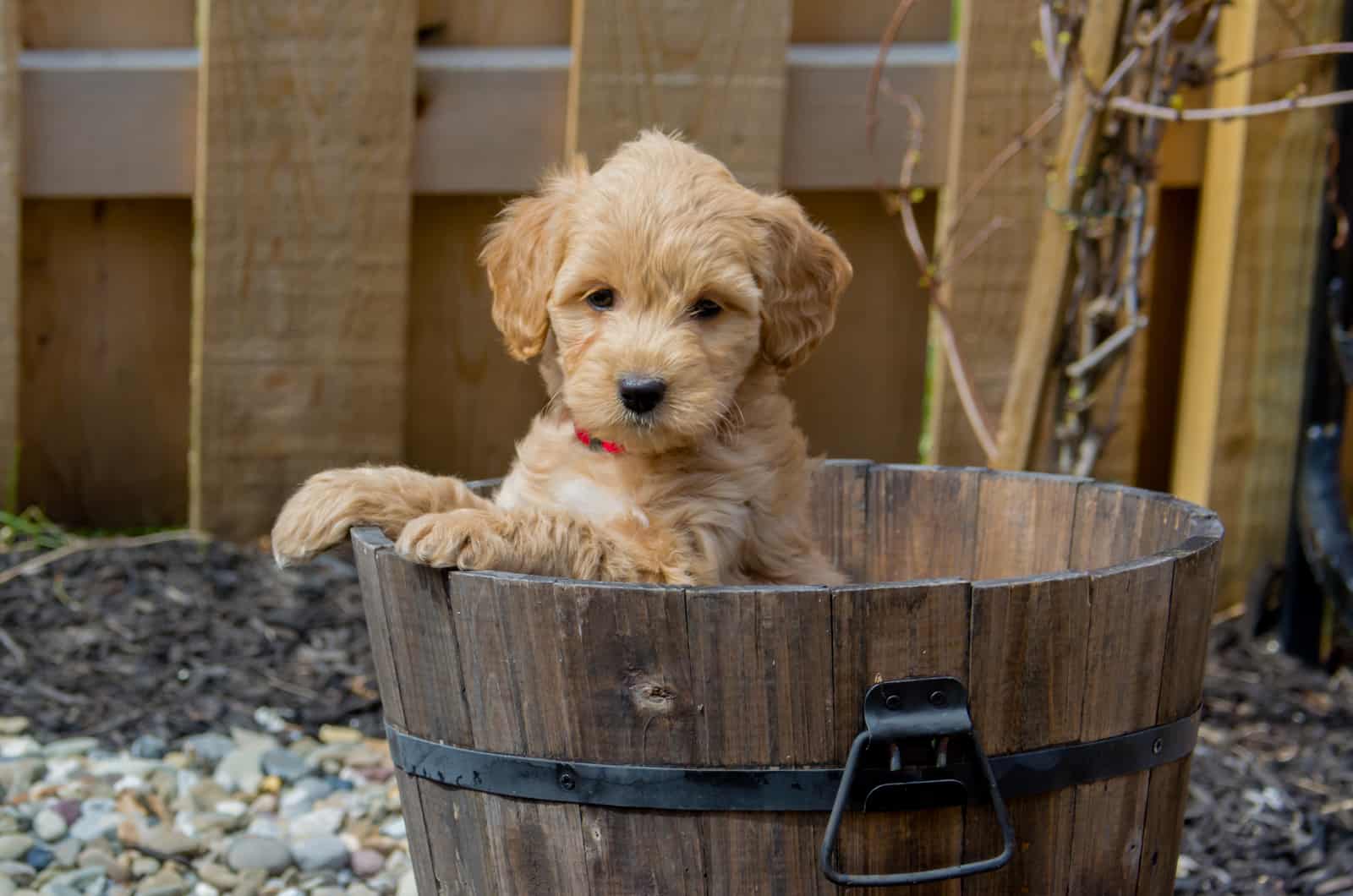
Puppies that have a straight coat usually inherited this trait from their Golden Retriever parents, which rarely have waves in their hair, but rather smooth and silky fur.
Poodle and Golden Retriever genes can greatly impact the looks of their descendants, especially when it comes to the texture of their coats.
That is one of the reasons why Goldendoodles with curly hair take after their Poodle parents. These types of puppies are often described as teddy bears because of their physical appearance.
It’s time to find out how Goldendoodle pups get their hair so flat and what elements contribute to the development of this trait.
Genetic Background
This is one of the main reasons why certain Goldendoodles have flat hair texture rather than curly or wavy.
Even though a Goldendoodle puppy will acquire qualities from both a Golden Retriever and a Poodle, there is a small chance that two Goldendoodle puppies will develop the same set of features.
The reason for this is that each of the puppies will inherit the dominant gene that was wired into their DNA from one of the parents.
Some Goldendoodle puppies inherit genes from their Golden Retriever ancestors, while others resemble Poodle parents more as their DNA structure is dominated by Poodle genes.
Generations
The coat type of a specific Goldendoodle puppy is determined not only by its genetic makeup but also by the generations of crossbreeding that came before it and the generation to which the puppy itself belongs.
First-generation Goldendoodles, also known as F1 (first generation backcross) Goldendoodles, are Goldendoodle puppies whose ancestry includes both a purebred Poodle and a Golden Retriever.
In this scenario, the puppy will get one-half of its genetic makeup from a Poodle, and the other half of its genetic composition will come from a Golden Retriever.
However, the situation is a little bit different for other generations, such as F1b, F1bb, F2, F2b, and other Goldendoodles.
The Difference Between F1 and F1b Goldendoodles
The F1b Goldendoodle puppies, on the other hand, are bred by a combination of an F1 Goldendoodle dog with a purebred Poodle pup.
This means that the F1b Goldendoodles have 25% of Golden retriever genetic makeup and 75% of Poodle genes in their DNA structure.
Because of this, they will have a greater chance of having the desirable curlier coat of a Goldendoodle than the F1 puppies, which are still 50% Golden Retriever despite the fact that they were crossed.
Look for puppies with the F1b gene if you want your Goldendoodle to have the curlier, more teddy bear-like appearance that is typical of this mixed breed.
However, you should be careful with Goldendoodle generations when you decide to adopt or purchase a pup, as there are different types of Goldendoodles with different parents.
For example, if you get an F2 Goldendoodle puppy, you will get a canine that has an equal number of characteristics inherited from both parents.
The only distinguishing characteristic of this strain is that its offspring have the potential to develop the straight and flat coat of a straight-haired Goldendoodle in addition to having the double gene of a Golden Retriever.
Essentially, this means that the offspring of this strain is the most unpredictable in terms of coat type.
The Difference Between F2 and F2b Goldendoodles
F2 Goldendoodle puppies are direct descendants of a second generation, as they are a mix of two F1 Goldendoodles. This way, their physical characteristics can be influenced by the genes of their purebred ancestors or the genetic strains of their crossbred parents.
On the other hand, puppies known as F2B Goldendoodles are the offspring of a cross between an F1 and an F1B Goldendoodle. However, these pups can also be produced by the combination of a purebred Poodle and an F2 Goldendoodle doggie.
Given this information, it can be concluded that F2B Goldendoodle Puppies will have 62.5% Poodle genes and 37.5% Golden Retriever genes in most cases.
Puppies that inherit the F2B gene, according to these stats, are likely to be born with curlier hair and a greater degree of morphological similarity to the Poodle. This is because there is a greater proportion of Poodle DNA in their gene structure.
Age
There is a visible difference in coat structure as Goldendoodle pups become more mature. This isn’t necessarily related to the coat genes of the puppies but to the changes that dogs’ bodies go through as they develop into adult canines.
Between the age of five and seven months, the majority of the Goldendoodle puppies will start with the shedding process, but that is not the only difference that their coats will go through.
During this period, the hair structure of the pups will change as well, and their fur will turn into adult coats.
The change might take place all at once or gradually over the course of a few months.
Additionally, darker-colored Goldendoodle puppies have a chance of losing their deeper coloring as they become older and develop a lighter coat.
In most cases, the primary distinction between the coats of a puppy and an adult canine is in the structure of their hair.
The coat of a Goldendoodle adult is often coarser and more rigid in structure, in contrast to the thinner and softer coat of a Goldendoodle puppy.
There is a possibility that some pups will mature into adults with hair that is curlier or straighter than it was when they were younger.
Are Flat Coat Goldendoodles Hypoallergenic?
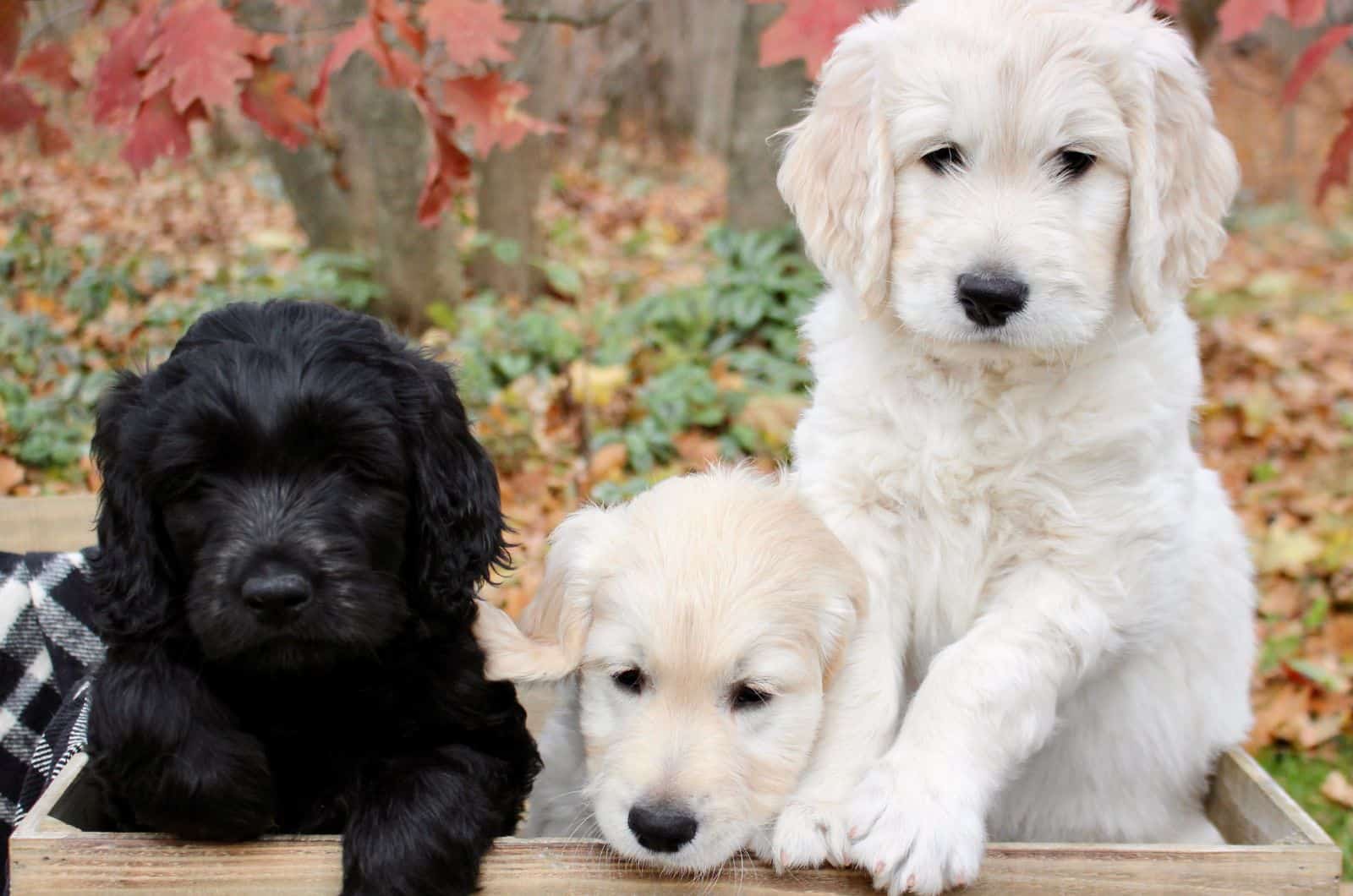
Goldendoodles with flat coats do not have hypoallergenic fur. You shouldn’t bank on the fact that they will be less of an allergy trigger than a purebred Golden Retriever, even if it’s possible that they could be.
Those who suffer from allergies should get an F1b Goldendoodle since there are higher chances their coat will be more similar to the one of the Poodle than that of a standard Goldendoodle.
Even Goldendoodles with curly hair are not a guarantee that the dog will not cause allergic reactions in certain people.
If you want a dog that has the highest possible chance of not aggravating your allergies, a Goldendoodle with straight hair is not the ideal option for you.
Instead, you should work toward breeding or purchasing a generation with DNA that is more similar to that of the Poodle, such as the F1b, F1bb, or F2bb.
Do Flat Coat Goldendoodles Shed A Lot?
Considering that they’re not hypoallergenic, there is a high chance that flat-coat Goldendoodles will shed more than other generations of this Doodle breed.
However, Goldendoodles with a straight coat normally have a modest amount of shedding.
Even though they probably won’t shed as much as a purebred Golden Retriever would, you should nevertheless prepare yourself for the possibility of having a lot of loose hair lying around your house.
The good news is that shedding can be properly handled in Goldendoodles with the right level of expertise and the appropriate grooming tools, such as brushes for Goldendoodles.
A balanced diet, regular grooming, and hygiene maintenance can keep your pup clean and fresh, as well as the usage of other appropriate tools (shampoos, conditioners, scissors, etc.)
Flat Coat Goldendoodle Grooming
When it comes to grooming, flat-coated Goldendoodles are considerably simpler to care for than their counterparts with curly coats, even if you have to put up with a small amount of shedding.
Due to the fact that they don’t shed as much as Golden Retrievers, they will require less frequent grooming, which will save you both time and money in the long run.
It can be said that they’re even better than other generations and types of Goldendoodles, as their coats are simpler to care for and require less upkeep than other coat types.
Straight coat Goldendoodles are less likely to develop tangles and mats than their curly-haired counterparts, which is a common source of frustration for the owners of curly Goldendoodles.
Brushing can be done once or twice a week, although I’d suggest at least three or four brushing sessions during the week, which will pick up all the excessive hair that would end up on your sofa or carpet.
How To Groom Your Pup
Owning a flat coat Doodle might cause confusion in dog owners as they might think that these pups require special care.
However, flat-coat Goldendoodle puppies require a similar grooming process as other types of Golden Retrievers, Goldendoodles, Labradoodles, Standard Bernedoodles, Standard Poodles, or any other long-haired pups.
RELATED: Top 9 Standard Poodle Breeders In Ontario (2022)
It is true that flat-coated pups are low maintenance, unlike curly-haired Goldendoodles, but they still need to be brushed and bathed regularly.
If you wonder how to keep your pup’s coat clean and well-maintained, here are a few tips that might come in handy, especially for first-time owners of these dog breeds.
Brush The Coat
Brush your pet’s hair gently but often, paying particular attention to the regions that are prone to irritation.
This can help prevent mats from forming on your canine’s coat if they are prone to developing them. If you detect a knot in your dog’s hair while you are combing it, grab a brush and brush it out gently.
• Be careful not to comb your pet for an extended period of time in the same location to avoid giving it a brush burn. You can verify this by searching under the fur to see if the skin has become red as a result of being irritated.
• Utilize both a comb and brush. Goldendoodles usually require equipment such as a steel comb, slicker and pin brushes, or undercoat rakes (which can be found on Amazon, Chewy, or other online shopping sites). These tools are also helpful in removing the undercoat from the dog’s coat.
They should remove loose hair and evenly distribute the oils that the skin produces throughout the coat.
Cut The Tangles That Can’t Be Brushed
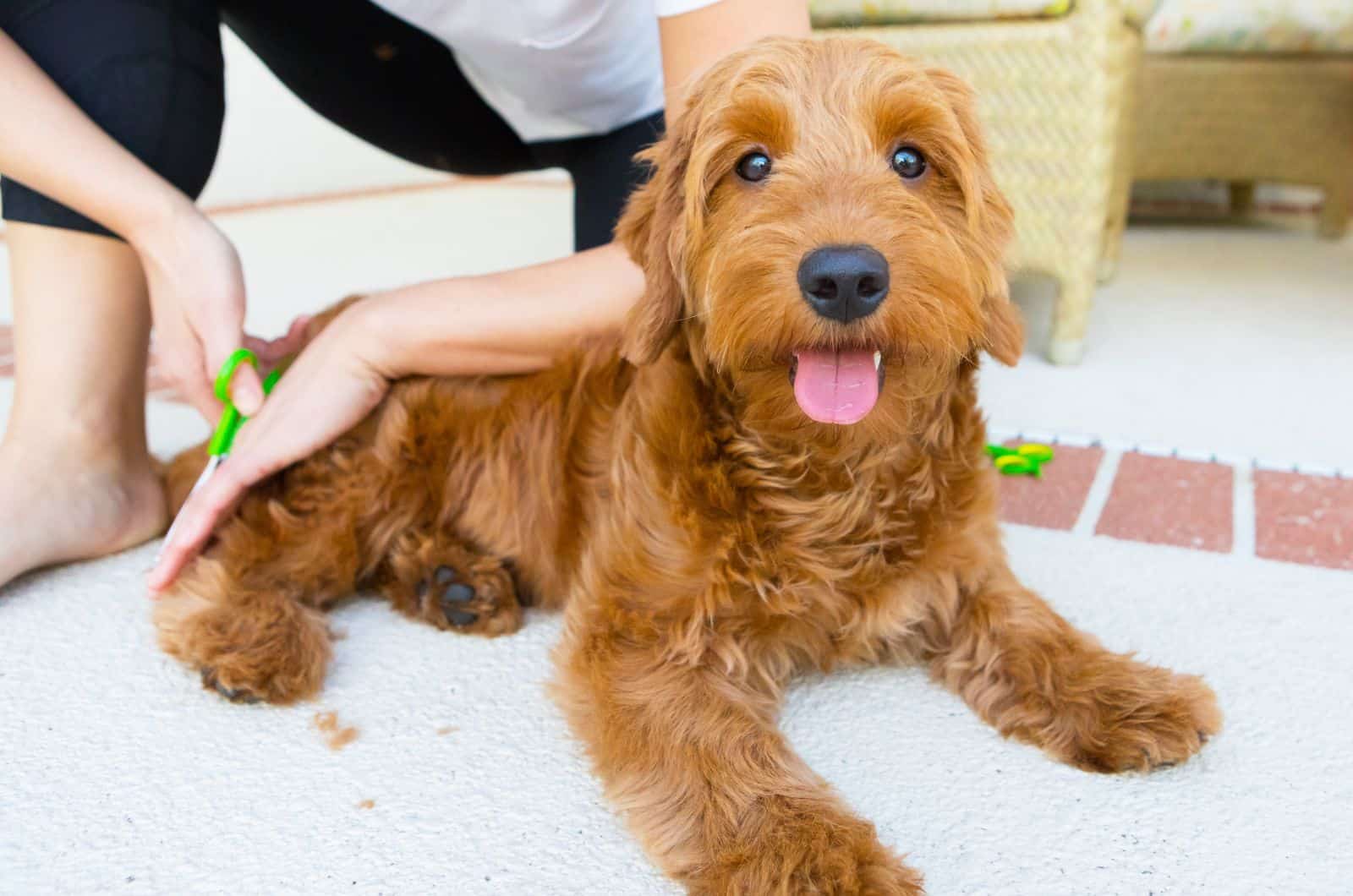
Severe matting can pull the skin even as the canine moves, which can make the dog’s daily existence uncomfortable and even painful.
If you are unable to remove a mat by brushing it away, you will need to either cut it off or shave it off, depending on how near it is to the skin.
• When you use scissors, exercise extra caution so that you do not injure either yourself or your pet. If you want to avoid a choppy appearance, try cutting the hair in a direction that is parallel to hair growth.
Take your dog to a professional groomer if you are unsure whether or not you will be able to remove the knots without causing harm to your pet.
• Under certain circumstances, when mats are pressed up against the skin for an extended period of time, bacterial infections may develop. If you have any reason to think that your dog has developed a skin condition, do not delay a visit to the vet.
• Redness and wetness are two of the most obvious signs of bacterial infection; a discharge may also be present in more severe situations. Your dog might lick, chew on, or scratch the area that is infected.
Bathe The Pup Regularly
If you don’t brush your dog’s coat before giving it a bath, you might end up with an even more tangled one than before. This is because getting the hair wet could cause the knots to become even more entangled.
Bathing your pet on a regular basis will keep its coat clean and without any tangles.
After the application of the shampoo, raking or brushing the double coat of the Goldendoodle with a brush or a comb can assist in the loosening of the tangled hair and better distribution of the shampoo.
However, you need to be cautious not to rake one region for too long to avoid any skin irritations.
Dry The Pup Appropriately
Keep in mind that Goldendoodles have thick and coarse coat hair, including flat coat ones. Not drying the fur properly could lead to unwanted health issues, which might include skin problems such as bacterial infections.
If towel drying doesn’t do the trick, you can try blow-drying your dog’s coat instead.
You will probably need to dry the coat of your canine while you are brushing it if your dog has longer fur.
Check that the setting on the hair dryer is set to the coolest possible temperature. It may take more time than normal, but the extra effort will be well worth it because there will be a decreased likelihood that your dog’s skin and fur will get too dry.
It is important to avoid letting the dog go outside while it is still dripping wet since the water might cause irritation and dryness if it is not at least towel-dried beforehand.
Clean The Dog’s Eyes
During the grooming process, you might need to remove any eye dust away from the edges of the pup’s eyes by wiping it away with a tissue.
Due to the fact that they are prone to getting tear stains, dogs with long or white hair may require additional care to ensure that all dirt is removed from their coats.
At a pet supply store, you may find treatments that are designed to remove “tear stains” from white coats.
Clean The Pup’s Ears
It is natural for a healthy ear to contain some wax, but there shouldn’t be any noticeable odor to it at all.
Applying ear cleanser, which can be purchased at a store that specializes in supplies for pets, to a cotton pad allows you to clean your dog’s ears.
Be careful not to use too much because it can run into your dog’s ear as you are cleaning it. Wipe the wax and debris away from the inner ear, but be careful not to rub too hard because this might cause sores to form.
Also, be careful not to press too deeply into the ear canal. If your dog has drop ears like a Basset Hound, you should wipe the inside of the ear flag as well as the outside since dirt gathers there as well.
When it comes to grooming, the golden rule is to clean just what can be seen.
Clip The Pet’s Nails
If Goldendoodle’s nails are not cut on a regular basis, they have the potential to curl down into the paw pads or twist the toes in a way that might cause injury to the joints.
You should cut your pup’s nails on a regular basis, the frequency of which should be determined by how quickly their nails grow.
If you can hear the nails on the ground as your pup walks, that is an indication that they are simply too long.
Flat Goldendoodle Pros
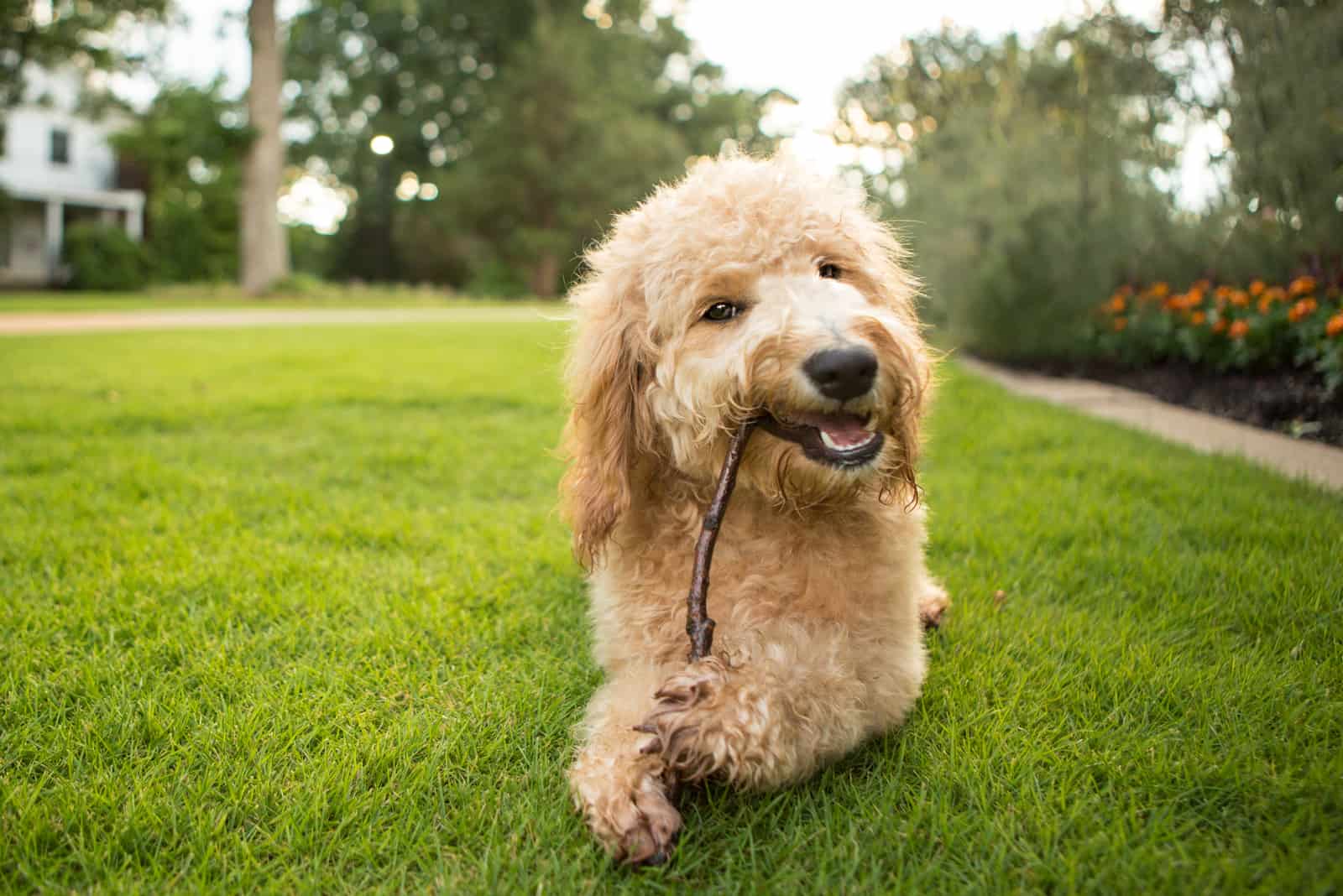
Reduced Need for Daily Grooming
Keeping the Goldendoodle’s straight hair healthy and nice looking will definitely take less time and work on your part.
Many people believe that having straight hair is the simplest hairstyle to maintain and style.
As a result, you won’t have to spend a significant amount of time maintaining the appearance of your four-legged companion.
Lower Price
The greatest number of Goldendoodles with smooth coats or straight hair is produced by the F1 and F2 Doodle generations.
That is partly the reason why these generations of Goldendoodles are usually lower-priced than those which have more of a teddy bear look.
Puppies with straight coats are more likely to be overlooked than those with curly coats since many people consider the flat Doodle coat a fault rather than just a type of fur.
Less Competitive Puppy Selection
You will often be able to choose a puppy before other potential owners, as the majority of people look for pups with wavy or curly coats rather than straight-haired Goldies.
If you don’t mind owning a flat coat Goldendoodle, you will probably be one of the first in line to get your pup from a Goldendoodle litter.
Unfortunately, many of these pups remain without forever homes as young puppies for this reason.
If you’re not looking for a canine for conformation events or dog competitions, there’s no reason not to consider getting a straight-haired Goldendoodle puppy and offer it a warm home filled with love.
Appearance Less Similar To A Poodle
Many dog enthusiasts prefer the appearance of the traditional Golden Retriever, which Goldendoodles frequently have, especially when it comes to coat colors they often inherit from Golden Retrievers.
Although Poodles shed less and have hybrid vigor, their appearance might not be as attractive to all lovers of Doodles, be it because of a Poodle’s coat colors, size, or other factors.
Less Regular Haircuts
The fact that a Goldendoodle sheds less regularly than other breeds implies that they will need their hair cut less regularly.
Their coats do not tangle or mat as easily as curly hair does, which is why it’s less likely that you’ll have to brush it on a daily basis.
You’ll be able to keep more cash in your pocket if you get your pet’s hair trimmed less frequently, which is a great advantage, for sure.
Flat Goldendoodle Cons
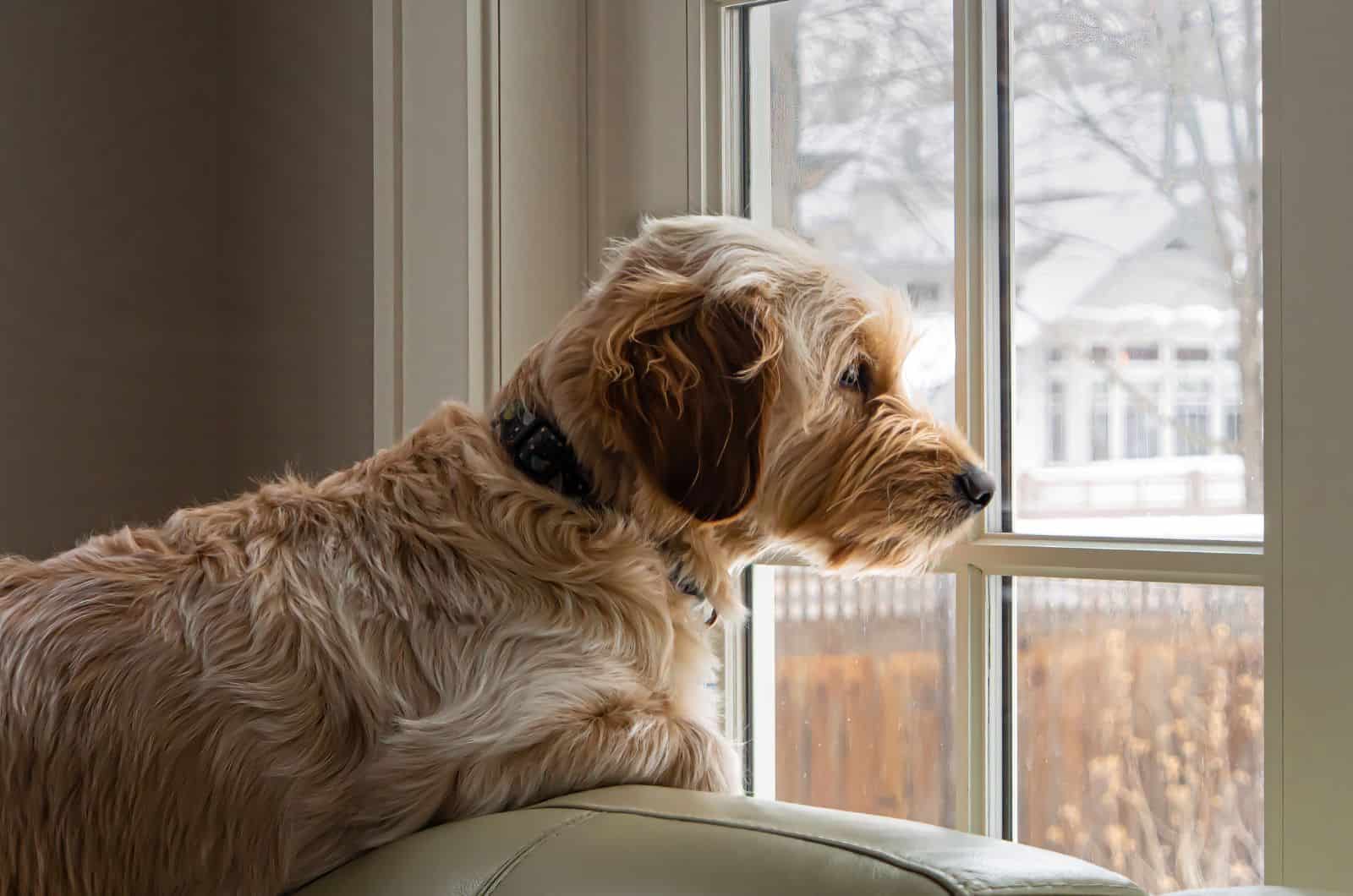
Goldendoodles With Flat Coats Have A Tendency To Shed
Standard Goldendoodles rarely shed because they usually inherit the genes of purebred Poodles. However, the situation is a little bit different with flat coat Goldendoodles.
This is due to the fact that flatter coats contain less Poodle genetics, which results in the puppy having a coat that resembles the fur of the Golden Retriever parents.
If you’re thinking about getting a Goldendoodle with a flat coat, you should be aware that the dog will leave loose hair quite often, especially during seasonal shedding.
Still, it’s important to mention that these Goldendoodles still shed significantly less than purebred Golden Retrievers.
Less Hypoallergenic
In general, Goldendoodles with flat coats have a tendency to be less hypoallergenic. This is due to the fact that they have a greater proportion of Golden Retriever genes than Poodle genes.
The hypoallergenic quality is typically associated with the non-shedding and curly coat characteristics of the dog.
Curly dog hair prevents allergens, such as dander and protein allergens, from falling off the skin of the pup, but it can also be one of the main causes of dander as well, especially if the fur isn’t brushed regularly.
How Rare Are Goldendoodles With Flat Coats?
Since Goldendoodles with curly or wavy coats shed the least of all types of Goldies, it is safe to conclude that they are the most popular kind of this breed.
Essentially, the goal was to develop a breed that had many of the same characteristics as the Golden Retriever, but with a coat that was less likely to cause issues for allergy sufferers.
On the other hand, Goldendoodles that have straight hair aren’t nearly as uncommon as one might expect.
Goldendoodles can end up with either straight or curly hair, despite the fact that most breeders want to breed Doodles with curlier coats.
If a Goldendoodle’s pedigree comprises an equal number of purebred parents, then the Goldendoodle will naturally have a higher chance of having a straight coat.
For instance, Goldendoodle combinations that contain 50% Golden Retriever and 50% Poodle are more likely to have puppies with straight hair than Goldendoodle mixes that contain a higher percentage of Poodle genes.
Wrapping Up
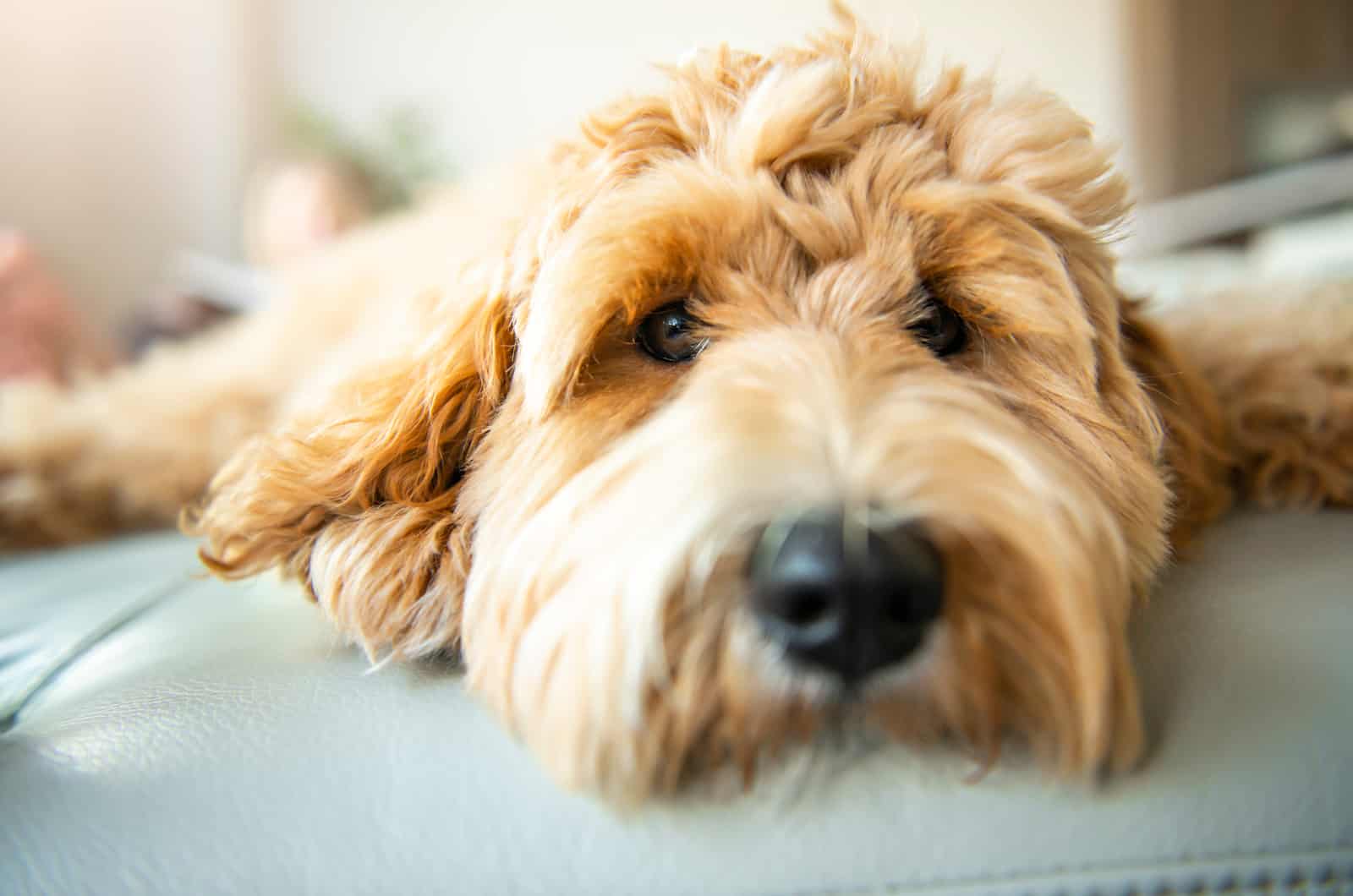
Owning a flat coat Goldendoodle is a blessing for many people who decided on getting a Doodle of this type.
There are many reasons why flat-coat Goldendoodles are a great choice for all those who would like to own this type of mixed-breed pup.
However, one of the main reasons would be that you’re getting a Golden Retriever-like pup that doesn’t shed nearly as much as the purebred canines do.
These types of Goldendoodles are like a lottery: breeders can’t know what they’re going to get unless they do genetic testing before the breeding takes place.
Only DNA tests can show precisely whether any potential coat changes might occur in a litter. The KRT71, or Cu locus gene, usually shows whether there are any chances future Goldendoodle puppies will end up with a straight or curly hair texture.
Even though it comes with downsides like shedding, a flat coat Goldendoodle is still worth owning and should be treated equally to their curly-haired counterparts.
READ NEXT:
Goldendoodle Breeders: How Do You Know Which Ones To Trust?
Goldendoodle Names: Finding The Cutest Name Idea For Your Teddy Bear
